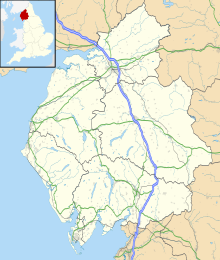|
Pate Hole
Pate Hole is a solutional cave located adjacent to Asby Gill 1 kilometre (0.62 mi) south of Great Asby in Cumbria, England. It is 970 metres (3,180 ft) long and has a vertical range of 33 metres (108 ft). The entrance is normally dry, but in flood it becomes an impressive resurgence.[1] Its name derives from the north country word for badger.[2] It consists of three main passages. From the entrance a stooping height passage heading south-east reaches a large 6 metres (20 ft) deep pool after 330 metres (1,080 ft) from which a stream emerges. This flows down a low passage to the north for some 270 metres (890 ft) where a sump is reached. The third main passage continues south underwater from the pool for 225 metres (738 ft) at a depth of 27 metres (89 ft) where it reaches a junction and becomes too restricted.[1] The cave is formed in Carboniferous limestone,[3] and is thought to drain the Great Asby Scar area 3 kilometres (1.9 mi) to the south-west.[4] The resurgence is presumed to be St. Thomas's Well in Great Asby.[5] The main part of the cave has been known for a long time, and it was an object of curiosity in the nineteenth century.[6] A brief foray into it was described in The Gentleman's Magazine in 1791,[7] and a description appeared in The Monthly Magazine in 1802.[2] The first full description complete with passage lengths appeared in 1813.[8] The first account of an exploration by cavers was in 1941 by members of the Yorkshire Ramblers' Club,[9] and in November 1946 it was surveyed by a group from Appleby Grammar School led by Brian Price.[10] The upstream sump was first dived for about 10 metres (33 ft) to a descending rift in 1960 by members of the Cave Diving Group, at which time the main part of the cave was re-surveyed by Warburton et alia. Further exploration took place in 1975-1976 by members of the same group to reach the current limit.[4] References
|
||||||||||||||||||||||||||||

